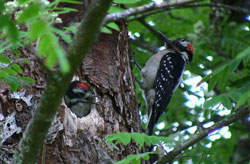A Guide to Building and Placing Birdhouses
Introduction
Alaska's Cavity-Nesting Birds
- * Common Goldeneye
- * Barrow's Goldeneye
- * Bufflehead
- * Hooded Merganser
- * Common Merganser
- * American Kestrel
- Hawk Owl
- * Boreal Owl
- * Saw-Whet Owl
- Black Swift
- Vaux's Swift
- Yellow-Bellied Sapsucker
- * Downy Woodpecker
- * Hairy Woodpecker
- Three-Toed Woodpecker
- Black-Backed Woodpecker
- * Common Flicker
- * Tree Swallow
- * Violet-Green Swallow
- * Black-Capped Chickadee
- * Siberian Tit
- * Boreal Chickadee
- * Chestnut-Backed Chickadee
- * Red-Breasted Nuthatch
- Brown Creeper
- Winter Wren
- * Mountain Bluebird
- Wheatear
- * Starling
- * Snow Bunting
* These species will use birdhouses.
 Providing houses for swallows, chickadees, snow buntings, waterfowl, and small owls is an
enjoyable hobby for any Alaskan who enjoys wildlife around their home or community.
Birdhouses built according to specifications, placed in the proper habitat, and maintained regularly benefit both birds and people. But, incorrectly built or maintained houses either will not be used by birds, or worse, become death traps for nesting birds. The following information is meant to help you build birdhouses suitable for Alaskan birds. More information on birdhouses can be found at your local library or bookstore.
Providing houses for swallows, chickadees, snow buntings, waterfowl, and small owls is an
enjoyable hobby for any Alaskan who enjoys wildlife around their home or community.
Birdhouses built according to specifications, placed in the proper habitat, and maintained regularly benefit both birds and people. But, incorrectly built or maintained houses either will not be used by birds, or worse, become death traps for nesting birds. The following information is meant to help you build birdhouses suitable for Alaskan birds. More information on birdhouses can be found at your local library or bookstore.
Birds that nest in cavities are the only ones attracted to nest boxes. In Alaska, 30 bird species nest in cavities, and 21 of these will use birdhouses. Excepting Snow Buntings, which nest in natural and man-made cavities in tundra areas, most cavity-nesting birds prefer to nest in holes in trees.
Tree cavities are formed by tree disease and decay and by woodpeckers. All six woodpecker species in Alaska excavate cavities for nesting and roosting. Most other cavity-nesting birds use abandoned woodpecker holes. Usually a pair of woodpeckers excavates a new hole every year. Before selecting a final nest site, a pair may start, then abandon, several holes. During fall, overwintering woodpeckers also excavate cavities for winter roosting. However, woodpeckers are only able to excavate holes in dead or decaying trees. Thus, natural cavities are sparsely distributed, particularly in young forests, in areas with low woodpecker populations, and in areas where dead trees have been cut down. In these types of areas, cavity-nesting birds often have difficulty finding nesting and roosting sites and will readily use suitable birdhouses.
Properly constructed birdhouses provide nesting and roosting birds the same protection as natural cavities in trees. This includes protection from wind, rain, cold, and nest predators (red squirrels, weasels, ravens, crows, jays, etc.).
